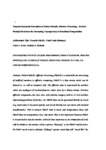Towards Harmonic Extensions of Pulsed Melodic Affective Processing Further Musical Structures for Increasing Transparency in Emotional Computation
| dc.contributor.author | Kirke, AJ | |
| dc.contributor.author | Miranda, ER | |
| dc.date.accessioned | 2016-10-26T16:50:09Z | |
| dc.date.available | 2016-10-26T16:50:09Z | |
| dc.date.issued | 2014 | |
| dc.identifier.issn | 1548-7199 | |
| dc.identifier.issn | 1548-7202 | |
| dc.identifier.uri | http://hdl.handle.net/10026.1/6632 | |
| dc.description.abstract |
Pulsed Melodic Affective Processing (PMAP) is a method for the processing of artificial emotions in affective computing. PMAP is a data stream which can be listened to, as well as computed with. The affective state is represented by numbers which are analogues of musical features, rather than by a binary stream. Previous affective computation has been done with emotion category indices, or real numbers representing positivity of emotion, etc. PMAP data can be generated directly by sound and rhythms (e.g. heart rates or key-press speeds) and turned directly into into music with minimal transformation. This is because PMAP data is music and computations done with PMAP data are computations done with music. Why is this important? Because PMAP is constructed so that the emotion which its data represents at the computational level, will be similar to the emotion which a person "listening" to the PMAP melody hears. So PMAP can be used to calculate "feelings" and the result data will "sound like" the feelings calculated. Harmonic PMAP (PMAPh) is an extension of PMAP allowing harmonies to be used in calculations © 2014 Old City Publishing, Inc. | |
| dc.format.extent | 199-217 | |
| dc.language.iso | en | |
| dc.subject | Communications | |
| dc.subject | Human-Computer Interaction | |
| dc.subject | Music | |
| dc.subject | Affective Computing | |
| dc.subject | Boolean Logic | |
| dc.subject | Neural Networks | |
| dc.subject | Emotions | |
| dc.subject | Multi-Agent Systems | |
| dc.subject | Robotics | |
| dc.subject | Harmony | |
| dc.subject | Computation | |
| dc.title | Towards Harmonic Extensions of Pulsed Melodic Affective Processing Further Musical Structures for Increasing Transparency in Emotional Computation | |
| dc.type | journal-article | |
| dc.type | Article | |
| plymouth.author-url | https://www.webofscience.com/api/gateway?GWVersion=2&SrcApp=PARTNER_APP&SrcAuth=LinksAMR&KeyUT=WOS:000334557500004&DestLinkType=FullRecord&DestApp=ALL_WOS&UsrCustomerID=11bb513d99f797142bcfeffcc58ea008 | |
| plymouth.issue | 3 | |
| plymouth.volume | 10 | |
| plymouth.publication-status | Published | |
| plymouth.journal | INTERNATIONAL JOURNAL OF UNCONVENTIONAL COMPUTING | |
| plymouth.organisational-group | /Plymouth | |
| plymouth.organisational-group | /Plymouth/Faculty of Arts, Humanities and Business | |
| plymouth.organisational-group | /Plymouth/REF 2021 Researchers by UoA | |
| plymouth.organisational-group | /Plymouth/REF 2021 Researchers by UoA/UoA33 Music, Drama, Dance, Performing Arts, Film and Screen Studies | |
| plymouth.organisational-group | /Plymouth/Users by role | |
| plymouth.organisational-group | /Plymouth/Users by role/Academics | |
| plymouth.organisational-group | /Plymouth/Users by role/Researchers in ResearchFish submission | |
| dc.identifier.eissn | 1548-7202 | |
| dc.rights.embargoperiod | Not known | |
| rioxxterms.licenseref.uri | http://www.rioxx.net/licenses/all-rights-reserved | |
| rioxxterms.type | Journal Article/Review |


